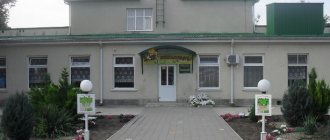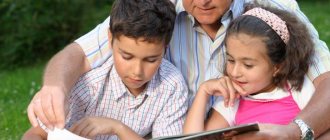Senior group. Senior preschool age. Children 5-6 years old
Gatherings at the mini-museum “Good responds with kindness. Bazhov’s tale “The Blue Snake” (senior age) Venue: mini museum of kindergarten : “Russian Izba”
Topic: Mercy, kindness, responsiveness, obedience - disobedience, love - selfishness, responsibility, independence, happiness, understanding of loved ones, gratitude, friendship, mutual assistance, courage, support,...
Abstract of the OOD in the senior group “Excursion to the mini-museum of Russian folk toys” Purpose: acquaintance with Russian folk toys. Objectives: - to create conditions for children to consolidate knowledge about Russian folk toys: Dymkovo, Filimonovsky, Bogorodsky, Stary Oskol, rag dolls, nesting dolls; - to form an idea of the materials from which...
Mini-museums in kindergarten - Scenario for the event “Mini-Museum of Bread” in a senior speech therapy group
Publication “Scenario for the event “Mini-Museum of Bread” in the senior speech therapy department...” Educator: Dear guests! Our group has a mini-museum of “Bread”. Now the children will present exhibits that are in our museum. M. Gelya: “This is our mini-museum of “Bread.” There is a cake, Santa Claus's bakery, a loaf of bread, a fairy tale theater "Spikelet", a plowman, a lark bird,...
An excursion with older children to the mini-museum “Cosmos” on the theme “The Sun is a Big Star” An excursion with older children on the theme “The Sun is a Big Star” Purpose: to develop ideas about the Sun as a hot celestial body of a spherical shape, and its meaning in the life of plants and animals. The teacher meets the children at the mini-museum “Cosmos”. - Hello, I am…
Summary of the conversation “Excursion to the mini-museum of a preschool educational institution with children of the senior group “My region on the map of the Motherland” “My region on the map of the Motherland” Goal: the formation of patriotic feelings based on enriching knowledge about the Motherland. Objectives: - consolidate children’s knowledge about the Motherland based on acquired information; - to form ideas about the small homeland; - to cultivate a sense of admiration and pride for small and...
Mini-museum in the senior group of the kindergarten “Kubansky Life”
Introducing to the culture and traditions of the people is especially important in the preschool years. It is during this period that it is necessary to create conditions for the disclosure of all the inclinations and abilities of the child, his creative potential. And it is necessary to begin familiarization with the values of folk culture...
Presentation of the project “Mini-museums, Worlds in groups of preschool educational institutions” - presentation
Pedagogical project Mini-museum (Worlds) at the preschool educational institution Steineprice E.A., MADOU “Kindergarten 252”, Barnaul, 2017
Living is like running through a museum. And only then do you begin to truly realize what you saw, think about it, consult books and remember because you cannot accept it all at once. Omar Khayyam
Features of museum pedagogy Helps solve almost all problems of preschool education Helps solve almost all problems of preschool education Plays a big role in the formation of the child’s value system, in Plays a big role in the formation of the child’s value system, in his familiarization with the historical, cultural and natural; cultural and natural heritage heritage Provides visibility of the educational process, promotes Provides visibility of the educational process, promotes the interaction of the preschool institution with the family and society the interaction of the preschool institution with the family and society
Mini-museums (“Worlds”). These are mobile environmental elements created by children together with adults and performing the functions of deeper and more comprehensive mastery by pupils of the content of current cognitive topics, the development of cognitive interests and individual preferences. These elements of the environment are used already from the younger group and their content is related to the requirements and objectives of such areas of children's development as cognitive-speech, social-personal, artistic-aesthetic. Developmental “Worlds” (shelves with items of redundant information). This element of the environment is required from a young age. It performs the functions of enriching children’s ideas (mainly in the area of unclear knowledge) and developing cognitive activity. Some of the development shelves are designed to present new ways of activity, promising ideas, and indicate interesting topics for free communication. Educational work plans provide for special time for work in mini-museums (cognitive and heuristic conversations, philosophical conversations, get-togethers, etc.).
The selection of objects should provide children with various information that allows them to generalize, analyze, and carry out experimental and search activities with objects. Objects are, first of all, carriers of cultural and historical experience. From them, in different places of the group, it is necessary to create complexes of WORLDS (in the philosophical meaning of the word): “World of Transport”, “World of Forest”, “World of Professions”, “World of Science”, etc.
Relevance of the project Ensuring the intellectual and personal development of the child. Introducing children to universal human values. Interaction with the family to ensure the full development of the child. Development of cognitive and research activities in preschool children in the system of museum pedagogy. Ensuring visibility of the educational process, which contributes to the interaction of the preschool institution with the family and society.
Project type Practice-oriented, long-term, collective, aimed at the triad: teacher, parents, children.
Goals and objectives of the mini-museum It is an effective module of a subject-development environment; It is a means of individualizing the educational process; Promotes the development of creative and logical thinking, imagination; Helps to educate preschoolers about the fundamentals of museum culture, broadens their horizons, and opens up opportunities for independent research activities; Helps to establish cooperation between the teaching staff and parents. Promotes the development of coherent speech, the ability to speak in front of listeners, and be a tour guide.
Feature of the mini museum Preschoolers feel involved in the creation of the mini museum exposition, participate in the discussion of the topic, and the collection of exhibits. You can visit it every day. In an ordinary museum, a child is a passive spectator and contemplator, but here he is a co-author, a creator. And not only himself, but also his parents. The mini museum is the result of communication and collaboration between teachers, children and their parents.
When creating a mini-museum (the World), it is necessary to follow the following principles: 1. The principle of integration. Mini museums should be created taking into account the content of the educational program of a preschool institution and help implement its general objectives. A museum is a unique way of understanding the world around us, therefore it reflects the most diverse aspects of our life, which are closely interconnected. 2. The principle of activity and interactivity. When selecting exhibits, it is necessary to remember that a mini museum should provide the child with the opportunity to implement different types of children's activities, support children's initiative: play with exhibits, make crafts, draw, etc. (a corner for independent activities must be allocated) 3. The principle of scientificity. Despite the fact that mini museums are created for preschoolers, their exhibits must reliably reflect the stated theme and explain various processes and phenomena. 4. The principle of conformity to nature. When organizing a mini museum, it is necessary to take into account the psychophysical characteristics of children of different ages 5. The principle of cultural conformity. The mini museum introduces preschoolers to world culture, universal human values (attitude to nature, culture, people) through the development of values and norms of a specific nationality and regional culture.
Principles 6. The principle of humanization and partnership. The mini museum is focused on creating conditions for the comprehensive development of the child, supporting his initiative, creativity and creating conditions for new partnerships in the “child-teacher” system (dialogue communication). 7. The principle of dynamism and variability. This principle is related to the principle of interactivity. A mini museum should periodically change in theme, exhibits, and the content of corners for independent and playful activities. 8. The principle of diversity. Exhibits should be varied in form, content, and size. 9. The principle of environmental friendliness. The exposition should be dominated by exhibits that are environmentally friendly for children’s health. 10. The principle of continuity.
Pedagogical functions of the Educational project. Development of visual and auditory perception, assimilation of information. The use of didactic materials that expand the scope of the curriculum and stimulate interest in art. Developmental. Activation of thinking. Development of intellectual feelings, memory, sensory-physiological structures. Enrichment of vocabulary. Educational. Formation of personal qualities, views, beliefs. Formation of mental, moral, labor, aesthetic and environmental education. Educational. Formation of abilities and skills. Formation of an adequate, meaningful attitude towards the information received.
Features of a mini-museum in a preschool educational institution Participation in the creation of a mini-museum of teachers, children and parents. The child is an active participant in the design of the museum exposition. The mini-museum is a zone of surprise, creativity and collaboration between children and their parents.
Stages of the project Preparatory Selecting a theme and name (for example, “Museum of Water”, “Museum of Time”) Selecting a location (group room, group reception room, etc.; Determine the content of the exhibition: equipment, materials, objects; Consider options for children and parents to participate in the creation of the museum; Determine the prospects for the development of the project. Excursions (sightseeing, thematic, educational)
Main stage Determination of the topic and content of the excursion; Drawing up an excursion plan; Communicating with visitors to summarize the information received and answer questions.
Summary stage What was done? What did you like most? What new did you learn? What else would you like to know? With whom can we share the knowledge we have gained?
The expected result is to make the word “Museum” familiar and attractive to children; - will introduce children to the world of universal human values, expand cognitive interest and emotional perception; — will allow the mini-museum to be replenished with new exhibits; — will assist in children’s assimilation of cultural elements, expand their vocabulary by selecting riddles, proverbs, sayings, and interesting materials for the exhibition. - will contribute to children’s ability to speak to an audience and act as tour guides. - will enrich the subject-development environment in the preschool educational institution. - will allow preschoolers to develop a sense of pride in a common cause, their group, kindergarten, family and small homeland.
Formula for success: the needs of the child + the interests of parents + the capabilities of teachers + the capabilities of the institution. Candidate of Pedagogical Sciences, Associate Professor of the Department of Preschool Pedagogy AltSPA Mayer A. A.




